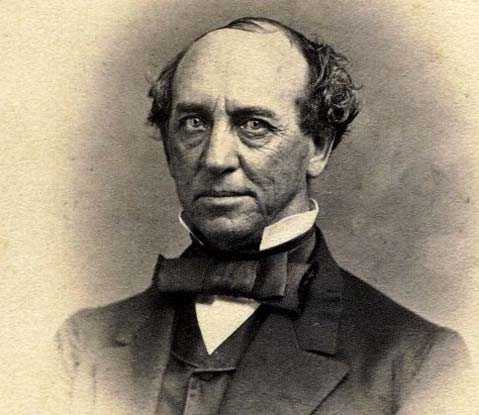Alfred Robinson
Seafarer Settles in Santa Barbara

One of the most prominent Americans to call Santa Barbara home during the era of Mexican rule in Alta California was Alfred Robinson. His memoir, Life in California, is an invaluable account of society as it was during the first half of the 19th century. Robinson became an important business figure locally and later statewide and came to know many of California’s political and business leaders of the period.
A native of Boston, Robinson began a seafaring career while still a boy. In 1829 he signed on as a clerk on the trading vessel Brookline, heading for California. The ship belonged to Bryant, Sturgis & Company, the leading American firm in the hide and tallow trade with California. At that time, cattle were prized not for their meat, but for their hides; the tallow that was used for candles and other products; and for the horns, which were made into buttons, among other items.
Robinson became an agent for the company. He traveled up and down the California coas,t arranging for the trade of hides and tallow in return for various manufactured items supplied by the firm. Alta California was very much a frontier society and manufactured items were scarce and highly prized. The arrival of a Bryant, Sturgis ship was a major event in California ports of call.
Robinson set up his Santa Barbara headquarters in a modest adobe near the present-day intersection of State and Carrillo streets. Here were both his office and living quarters. He quickly became acquainted with the prominent citizens in town, including José de la Guerra, presidio comandante and one of the largest landowners in all of Alta California.
At some point, one of de la Guerra’s young daughters, Ana María (also known as Anita), caught Robinson’s eye. Late in 1834, Robinson wrote her father to ask for her hand in marriage:
“For some time I have wished to speak with you regarding a matter so delicate that, in the act of explaining it, words have failed me to express myself as I should in order to reveal the service which only you have the power to grant and to be the author of my felicity. … Her attractions have persuaded me that without her I cannot live or be happy in this world. Consequently, I am begging for her hand.”
The couple married in 1836. The bride was 15. The wedding festivities were immortalized in Richard Henry Dana’s Two Years Before the Mast, a best-selling account of his travels aboard the brig Pilgrim. The ship happened to be at Santa Barbara at the time of the wedding.
Toward the end of 1837, the Robinsons moved to Boston. Robinson felt his wife would benefit from some Eastern schooling. For the next several years, Robinson shuttled back and forth between the two coasts. He brought his family back to his wife’s hometown in 1854, but tragically, Ana María died the following year. Reportedly, Robinson never got over his wife’s death. He largely severed his ties with the de la Guerras and eventually moved to San Francisco. He died there in 1895.
As revealed in Life in California and other writings, Robinson had an ambivalent, bifurcated view of Mexican California. He did not think highly of the Californio work ethic, “You might as well expect a sloth to leave a tree that has one nick of bark left upon its trunk, as to expect a Californian to labor, whilst a real glistens in his pocket.” Yet he had great respect for selected individuals, especially his father-in-law. Although he referred to Native Americans as “savages,” he was incensed by the treatment they received. He saw much to admire in the mission system, yet wrote, “The missions were like a large prison.”
Robinson viewed the Mexican authorities, during a period of great political turmoil, as largely inefficient and corrupt. He opposed the war between the U.S. and Mexico of the late 1840s, yet still felt that the American movement westward would ultimately swallow up Alta California. “For the march of emigration is to the West, and naught will arrest its advance but the mighty ocean.” He did not view this prospect with unalloyed delight. He seemed to be conflicted about the land of his birth, his adopted country, and the clashes between the two.



